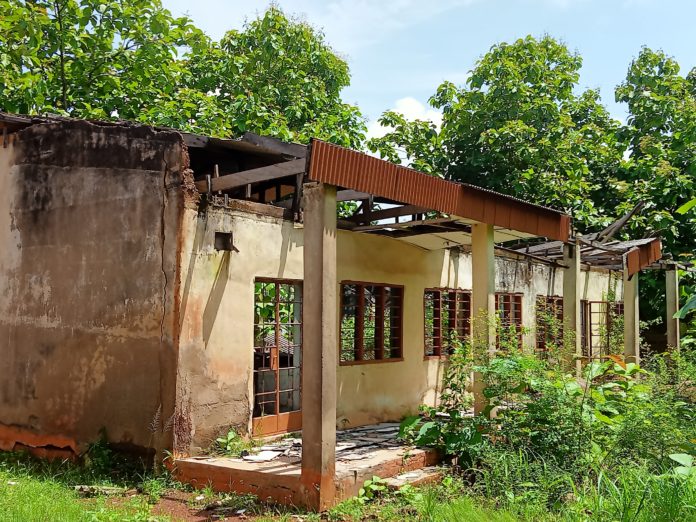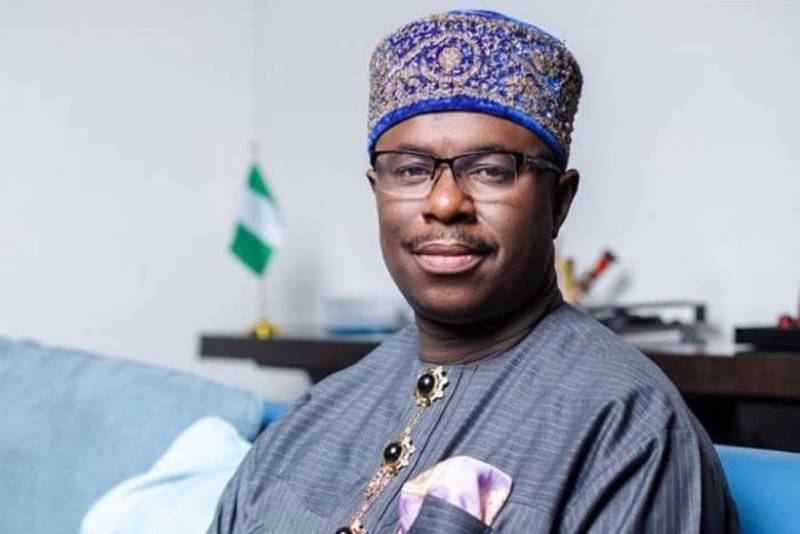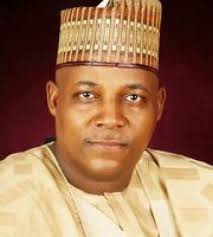INVESTIGATION: How Underfunding, Extortion, Unpaid Wages, Ruin Benue’s Secondary Schools – Part 1
In this report of a 3-month investigation, National Record’s Iduh Onah, Amos Aar & Denen Achussah, expose the appalling condition of secondary schools in Benue State. To be able to penetrate a strong wall of censorship of administrators of the schools by education managers in the state, the reporters often posed as researchers collaborating with UNICEF to carry out the needs and challenges of the schools.
By National Record
THE heap of ruins that Government Secondary School (GSS), Ulayi has become remains the most vivid symbol of the unspeakable decay of Benue State Secondary Schools.
Founded in 1976 and located in the present Ado LGA in Benue-South, the school had in the early 1980s and late 1990s a population of over a thousand students. By 31st May 2022 when this reporter (a 1986 alumnus) visited his Alma Mater, GSS-Ulayi had zero student, just one staff – the principal – and what used to be a campus bustling with students had become a jungle.
A young forest, about a decade in the making, and a thick green bush, with farms here and there, now occupy where there used to be the school’s Admin Block, Assembly Ground, classrooms, dining and examination halls. This scenario indicates that the meltdown was slow and steady with little or no effort at arresting the school’s slow and uncertain descent into ruin.
The school is in such a state that for this reporter to be able to access where there used to be classrooms and hostels, an indigene of the community, Otte Ochai, who is an old student and was there that day to help the principal’s wife clear a portion of the dilapidated residence where the principal lives with his family, came handy in helping to clear a path and guide him (reporter) through the emerging forest.
Asked how and what had brought the school to such tragic state, Otte could offer no cogent explanation and the principal, Mr Ogori, was away on WAEC supervision at the Methodist High School, Igumale, another school that is a complete ghost of its former pedigree.
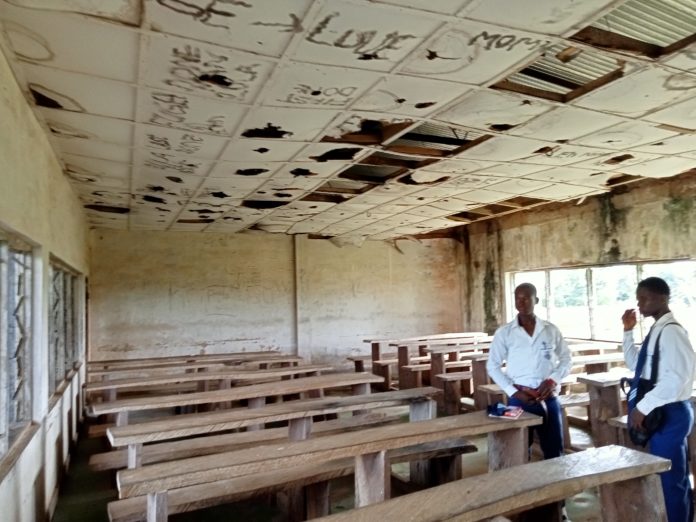
Mrs Ogori, the principal’s wife, who was home and was using a rundown part of the science laboratories to teach her children and about half a dozen other children of nursery and primary school ages, gave a narrative that drew both empathy and anger at the same time.
Mrs Ogori said she relocated to GSS-Ulayi last year only to discover the school in such a calamitous state.
GSS Ulayi may have suffered the worst fate amongst government-owned secondary schools in the state, but certainly same fate awaits more schools unless and only if an education emergency is declared soon by government. From the perilous conditions of other schools visited in the course of this investigation, the entire structure of formal learning and instruction in the state is in grave danger of either persistent dereliction or possible extinction.
As this story goes to press, employees of the Benue State government, including teachers and other staff at both primary and secondary schools on government payroll, have gone unpaid for over a quarter of the year – having not received their salaries consecutively for the months of April, May, June and July. In addition to this, they are owed outstanding arrears of five months from 2017.
Additionally, for over a decade now, and despite retirement and death of teachers, there had been no recruitment thereby leaving a big vacuum in the required number of teachers.
Schools visited confirm that the last time teachers were recruited was in 2012 and that at the moment, there exist a yawning gap leading to gross shortage of teachers. A principal of a secondary school told National Record in confidence that in the state’s teaching service today, one can hardly get teachers below grade level 12 as the last batch of those recruited are now on level 12 or above.
But top on the list of challenges is the monster of underfunding. Principals and management staff of secondary schools visited confided in National Record that for over ten years now, there has not been any budget for capital projects in secondary schools in the state, and that if there had been, they were not released to any school.
The litany of these dangerous dynamics coupled with broad allegations of arbitrary and illegal deductions from principals’ salaries and extortion by education officials combine to impose a suffocating dark pall over government secondary schools or those under government grant-aid scheme.
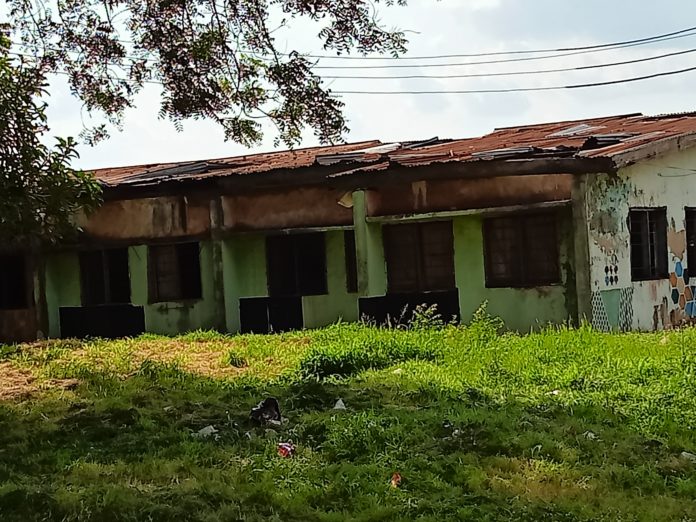
Our investigation reveals that though the decay cuts across all levels of education in the state, the deterioration of is however more intensive at the secondary level given the comprehensive and unspeakable decomposition of facilities, particularly in the government-owned colleges.
When contacted and asked for an interview to respond to allegations of non-payment of teachers’ salaries, underfunding, arbitrary deductions from salaries of principals, extortion by education inspectors, amongst others, the Commissioner for Education, Dr Saawuan Tarnongu, said he was unwell and on admission at a hospital. He however delegated the responsibility to the Executive Secretary of the Benue State Teaching Service Board (TSB), Dr Frank Kyungun, as secondary schools are under TSB’s direct purview.
In the interview with National Record,Dr Kyungun though declined to give specific figures when asked of the approximate figure of education budget since 2015 when Governor Ortom assumed office, he however admitted that there was generally underfunding of education.
“That question would have been better answered by my Hon. Commissioner of Education because he best knows the percentage and the budget allocated to the Ministry of Education. I’m just occupying a sector of Education, I’m in charge of secondary school education in Benue State. But when you talk about a broader perspective, he is better placed to answer that question.
“I don’t know how it was done in 2019 but from 2020 up to date, Education has been actually underfunded, that’s just the general view I have. If it’s not underfunded, we wouldn’t have been having difficulties in other activities in Education,” Dr Kyungun stated.
In the interview, Dr Kyungun also spoke on several issues including GSS Ulayi’s death which he admitted is a special case and are reflected below at the appropriate sections of this report.
Scale of decay
For people who received their secondary education in Benue State between the early 1970s and late 1980s, going back to their alma mater would be a painful odyssey as majority of the schools are now not just ghosts of their former selves but are literally squalid and uninhabitable ruins.
From Government College, Makurdi, where Gabriel Suswam, who was Benue State Governor between 2007 and 2011 to Government Secondary School, Otukpo, where George Akume, another former governor of the state (1999-2007) and current Minister of Special Duties and Inter-Governmental Affairs, finished from, and to all other government secondary schools spread across the 23 local government areas of the state; as well as all grant-aided schools; the story is the same – ramshackle facilities, inadequate but demoralised teachers, layers of imposed levies without impact, underfunding, poverty amidst arbitrary deductions, extortion, and unpaid salaries.
Schools as relics of history
From available records obtained last April from the Benue State Teaching Service Board (TSB) which directly regulates the state’s secondary schools, there are a total of 64 government secondary schools, 81 faith-based secondary schools, 101 community secondary schools and 61 single-proprietorship secondary schools. Added together, there are a total of 307 secondary schools that are formally under government full and partial funding under a policy called ‘grant-aid’.
While government has absolute control of secondary schools it established, its responsibility to grant-aided schools (mission or faith-based, community and single-proprietorship), in line with the policy of grant-aid introduced by the late Governor Aper Aku to boost education, is to support or assist (aid) schools by posting teachers on government payroll to them. The centralised employment and posting of teachers by government, National Record gathered, was to, first and foremost, ensure quality control, and secondly, as a subsidy to remove the huge financial burden that employing qualified teachers entail for private and non-profit organisations.
Contrary to this policy, and in view of the state of dilapidation of the schools visited by National Record in the course of the investigation, the Benue State Government has overtime not only failed in its core responsibility of minding the schools, it was also found that all the categories of schools are being fiscally abused and extorted by the government and its officials.
The result is that these schools, which were once booming centres of learning and breeding high quality students in the 1970s to the late 1980s and to some degree the 1990s, have literally collapsed and turned into mere relics of history, existing merely by name in government record. Over 97% of government secondary schools in particular lack any iota of standard deserving of a formal place of learning.
According to Reverend Father Francis Atama, the Education Secretary of the Catholic Diocese of Otukpo, in an interview with National Record,many of these schools in Benue State are “mere examination centres.”
The degree of dilapidation of the schools defies the logic of their location or proximity to the seat of power in a way that both those located in urban or semi-urban centres and those in the remote or interior communities suffer the same fate of crumbled or decomposing facilities – utterly wretched classrooms, staffrooms and staff quarters, insufficient teachers, ruined science laboratories, ancient and derelict computers where they exist, ditto technology workshops and sports facilities.
In Zone A, National Record visited a total of 17 secondary schools located in Katsina-Ala, Konshisha, Kwande, Logo, Ukum, Ushongo and Vandeikya LGAs. In Zone B, 15 schools visited include those in Buruku, Gboko, Guma, Gwer-East, Gwer-West, Makurdi and Tarka LGAs. For Zone C, 15 schools in Ado, Agatu, Obi, Ogbadibo, Ohimini, Oju, Okpokwu and Otukpo LGAs were visited.
In all the 47 schools visited in 21 out of the 23 local government areas of the state, the same challenges of crumbling facilities, dwindling student population, shortage of teachers, poor working condition, regime of levies and arbitrary deduction of the levies from principals’ salaries, are the common narratives.
Unlike in the 1970s to the 1990s when the norm was that all government secondary schools as well as mission schools, especially those operated by the NKST, Catholic and Methodist Churches operated exclusively as boarding colleges with full catering facilities; today, with the exception of the mission schools whose managements recently revived boarding, just a handful of state-owned secondary schools have the capacity and facilities for boarding system.
National Record also gathered that a major consequence of the decomposed infrastructure, dearth of teachers and poor remuneration, is an abysmally low student population in public and grant-aided schools across the state when compared to two or three decades ago.
Challenge of access to information
Of the government secondary schools visited, National Record was able to see boarding facilities in only Government College-Katsina-Ala, Government College-Makurdi, Government Secondary School (GSS), Gboko, Government Science and Technical College (GSTC), Otukpa and, perhaps, GSS-Otukpo. Perhaps because, it recently began experimenting with reintroducing boarding. Out of its about 400 students, it has only 15 students squeezed into a small hostel apartment converted from what looked like a ‘boys’ quarter.’
With the exception of Government College, Makurdi, Government College Katsina-Ala and GSS Gboko, and Government Day Secondary School, Otukpo, where National Record was denied information on state of facilities, all other government colleges visited do not have any vehicle for their activities.
In a few schools where these reporters were denied information and access to assess the state of facilities, there were clear indicators of dilapidation and lack of maintenance stamped on schools as one enters into their premises.
As it became obvious that getting basic information was not possible posing as journalists, these reporters had to operate as researchers gathering data for UNICEF, an excuse which succeeded largely with students, teachers and non-teaching staff including the principals, with a few refusing to cooperate saying they had been cautioned by the TSB against speaking to anyone except anyone with a letter of introduction from the agency.
The portraits of decay
GSS-Otukpo, which was founded in 1967, is located in the heart of Otukpo, a walking distance from the Palace of Och’Idoma, the traditional head of Idomaland. All the school’s hostel blocks are dilapidated beyond redemption. If boarding is to be reintroduced, the once modern hostels, the latest of which were constructed in the early 1980s by the Aper Aku administration have to be pulled down and rebuilt.
Apart from the collapsed hostels, all the classrooms are in very poor shape with few still with their window louvers intact. The ceiling of each classroom is either collapsed or sagging due to leaky roofs occasioned by sagging roofs. When it rains, students told National Record, lessons are put on hold as students and teachers are herded in corners that do not leak.
Most of the classrooms, with the exception of just two classrooms with about a hundred plastic chairs and desks said to have been recently supplied by the Ministry of Education, are dotted with broken wooden chairs and desks, while some others have few far less than required and students are forced to squeeze to share seats and desks.
The administrative block which houses the offices of the principal and the vice principals as well as the staffroom are equally in awful shape as the block is not spared of the decay with visible signs of leakage, broken windows, cracked walls and aged and dirty office furniture.
The principal of the school was not available when we visited while the vice principals were said to be engaged and could not see the reporter. However, students and some teachers who took these reporters round the school complained of the crumbling facilities, shortage of teachers, insufficient classroom furniture, lack of essential utilities like power generator, pipe borne water, borehole or water tanker, school vehicle, functional library and science laboratories.
“Our problems are many,” a teacher said when asked the challenges facing the school. “We do not have enough chairs and desks, water supply is very poor, it is private tankers that supply the school water; we have no school bus, so we usually have difficulties participating in inter-schools’ activities; if we must go, our principal usually hires one or two commercial buses depending on the number of participants.
“As you will see, our classrooms are not enough and they are all leaking and falling apart. At the beginning of this session, the principal told us that the school rejected many students who wanted admission because of the state of the school,” said the teacher, who pleaded anonymity.
Corroborating the teacher, an SS 2 student said a major challenge for science students is the state of the science laboratories and the total lack of ICT facilities. “We are only doing theory; our practical classes are also theory classes. If you see our lab, you will be shocked,” the student said.
The laboratories are junk rooms of expired chemicals and dirty apparatuses that have gone far beyond salvage. In the same trajectory of decay is the school’s library, which from its look, has obviously not been in use for a long time. Apart from the unkempt, collapsed shelves and dusty books, the library furniture are damaged, the ceiling leaking in many spots and threatening to collapse. Both the laboratories and library look more like abandoned junkyards than places of academic exercise.
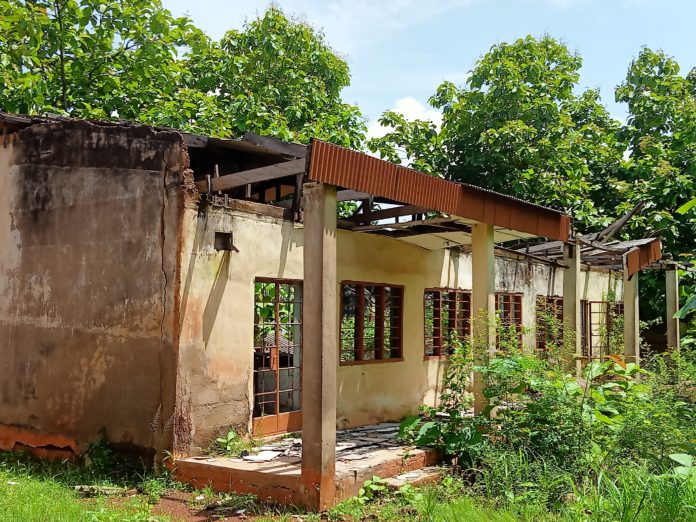
In GSS-Otukpo like a number of schools visited, there is visible impact of Parents Teachers Association (PTA) and forum of old students. Apart from renovation and construction of physical structures by GSS Otukpo Old Boys Association, some of its members made personal donations of desks and chairs. In two classrooms, National Record captured chairs donated by Dr J. Y. Musa, a 1982 set who is now a Senior Advocate of Nigeria (SAN).
***
Although GSS-Otukpo is in poor shape, it is however better compared to Government College (formerly Government Teachers College), Utonkon, founded in 1974. While Government College Utonkon in the 1980s used to be among the best schools in terms of infrastructure, student population and reliable training ground for primary school teachers, today, the school is barely alive. National Record gathered from teachers that it had recently been marginally revived having completely gone under and the campus overtaken by bush for almost a decade. More than two-third of the school is still a total ruin.
At the peak of its glory, said one of the teachers who conducted this reporter round what clearly were once celebrated architectural masterpieces for a secondary school, Utonkon was said to have accommodated over five thousand students, all boarded, with each set of a class of 50 or more, from the then Forms 1-5, operating classes from A to H or more.
Today, Utonkon has only 187 students barely filling the only two blocks of storey building that are not only unconducive for learning but even dangerous for use by both students and teachers. It has four government-paid teachers, 13 teachers paid by the PTA, and 10 corpers.
In all the classrooms, the windows’ wooden frames are rotten and louvers all broken, the roofs leaking with many of the classrooms dripping with rain water trapped in sagging ceilings. In fact, the examination hall, which used to be the dining hall, has the decked roof in one portion sagging so dangerously that the students and teachers ought to be awarded medals of courage for daring to enter.
The once solid buildings spread on the vast acres of property occupied by the school, National Record discovered, have undergone comprehensive decay that only a few of them, especially what used to be the girls’ hostels, are in condition for possible restoration. Some of what used to be boys’ hostels, majority of the classrooms and staff quarters have long collapsed or been overtaken by bush and consumed by wild fire or encroached on by the community.
***
With a student population of 157, Community Secondary School, Wadata, a working class suburb of Makurdi, has 54 academic staff. Although the management of the school declined comment, telling National Record that it would speak on the state of the school only if it gets express approval from the Executive Secretary of TSB, we were able to independently ascertain that the school is also caught up in the infrastructure debacle.
A source, who is a teacher in the school, but pleaded anonymity, said the school is in dire need of attention with its decaying infrastructure even though it has a commendable student-teacher ratio (two students to a teacher). He said a major challenge that comes with the high number of teachers is the inconsistency in the payment of teachers’ salaries which affects the morale of teachers.
National Record noted that the high teacher ratio may not be unconnected with the school’s location in the state capital to the detriment of many others in rural areas with just a handful of teachers.
***
Mount Saint Gabriel’s (MSG) Secondary School, Makurdi, a Catholic school founded in 1964, with a current student population of 776, is not as lucky as Community Secondary School Wadata in terms of number of state-paid teachers. It has 53 government-paid teachers and 66 PTA teachers.
A teacher who conducted National Record round the school said MSG needs intervention in the areas of boys’ hostels, toilet facilities, introductory technology workshop and the completion of a gigantic project – a block of classrooms and laboratories – by the old boys’ association of the school.
Compared to government-owned schools, MSG is far better administered and remains one of the best in terms of facilities many of which however require facelift.
***
Government College, Makurdi is one of the exchange schools in Nigeria but may have however lost its pride of place because of its decaying facilities due to underfunding by the state government.
A reliable informant in the school who guided National Record through some facilities revealed that Governor Ortom had in his first tenure awarded a contract for the school’s rehabilitation but as he enters his last year in office, contractors had since abandoned site complaining of government’s inability to meet contractual agreement for rebuilding the school. Therefore, like all other state-owned schools, buildings and other facilities at the college are also pleading for restoration.
***
In comparative terms, schools located in the urban and semi-urban centres are generally better with regard to access to teachers and student population. However, the challenge of infrastructure decay, funding, extortion, and decreasing population of students, among others, are common to all schools irrespective of location.
That the decay and the various dimensions of trauma and social dysfunction that accompany it had not caused public outrage over the years could either be a function of the iron-clad regime of censorship by government functionaries in the state’s education sector or despondence that pervades the entire state.
To be continued in Part 2

